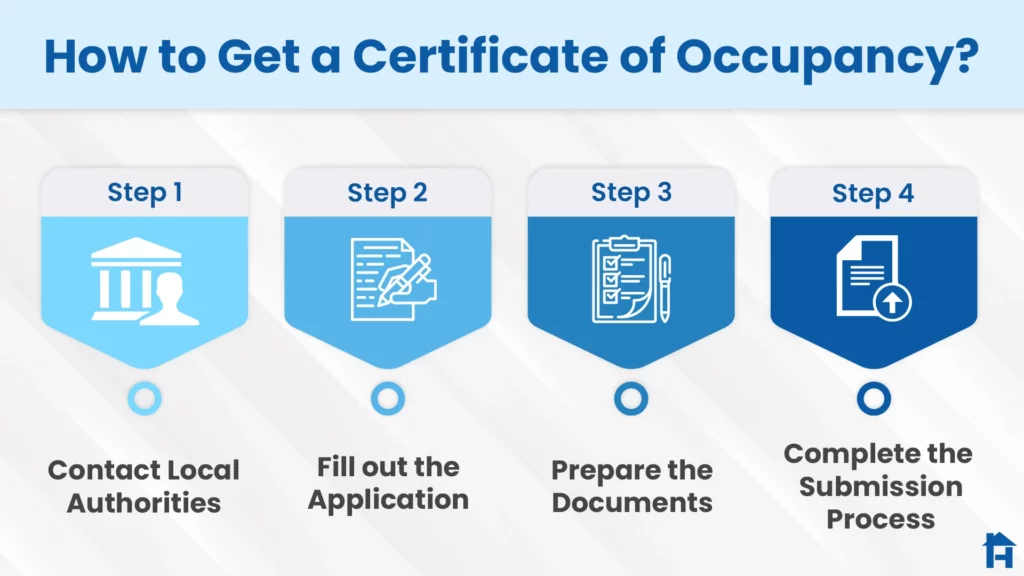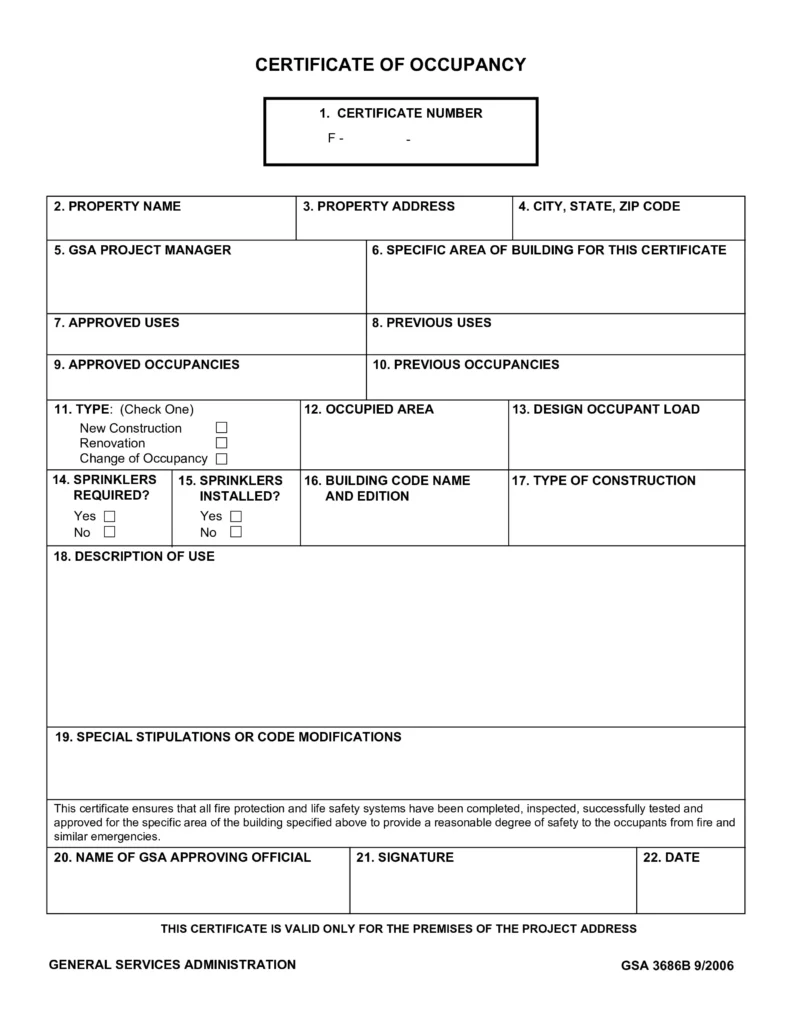88% of home buyers opt for a home inspection before their property purchase. Moreover, 86% of them don’t prefer to buy a home with structural and functional defects. This can impact your home sale significantly!
But here’s a silver lining- A Certificate of Occupancy. A CO proves that your home is safe to occupy and improves its sellability. Moreover, it helps you attract buyers and increases the chances of negotiation!
What Is a Certificate of Occupancy?
A Certificate of Occupancy is proof that your property is safe to live in and meets all the basic infrastructure requirements. These include structural stability, electrical systems, plumbing, fire safety measures, HVAC systems, and roofing.
You can’t legally occupy a property without a CO. Also, you must have an Occupancy Certificate when you sell a house or opt for major home renovations. Moreover, it helps you get competitive offers from potential buyers.
How Long Is a Certificate of Occupancy Valid?
When you get a Certificate of Occupancy, it stays valid until you make any renovation or expansion to your house. Furthermore, transferred ownership, change in property use or an update in zoning regulations call for a new Certificate of Occupancy.
What Is a Temporary Certificate of Occupancy?
Temporary CO is a document you get when your home has minor issues that do not pose a direct threat to the lives of the occupants. These issues are non-structural like pending interior decoration work or unfinished landscaping.
The TCO is valid for 90 days. In some states, you must reapply after every 30 days during that period. You cannot extend the validity of a TCO beyond 90 days.
What Is a Letter of No Objection?
A Letter of No Objection is an official statement that a building complies with the safety codes and zoning regulations. It proves that your apartment is suitable for its intended use. However, only the buildings constructed before 1938 require an LNO.
To apply for an LNO, carry the records showing the home’s historical and intended use to your local zoning office. The authorities will then verify all documents and inspect your home to check its compliance with the present zoning regulations.
Who Can Apply for an Occupancy Certificate?
- Home/Property Owners: You must apply for a CO when you build a house from scratch. You need to update it after every renovation.
- Builders/Contractors: After the completion of a construction project, the builders should present the final CO to receive their full payment. This certificate verifies that the building meets the safety codes.
Who Issues the Certificate of Occupancy?
The local building or zoning inspection office generally issues the CO. This office is often affiliated with the city or state government.
How Long Does a Certificate of Occupancy Take?
The time it takes to obtain a Certificate of Occupancy can vary from a few days to several weeks. This depends on factors such as your home inspection report and the specific requirements of your state or city.
Is a Certificate of Occupancy Mandatory in Your State?
Some states have strict whereas others have flexible rules about having a CO. Moreover, the city you are in might have a different set of regulations than your state too.
Check out this map to know whether you need a CO in your state:
When Should You Apply for a Certificate of Occupancy?
As a homeowner, you should apply for a Certificate of Occupancy in the following situations –
- Major Structural Renovations: Update your CO to prove that your recent home renovations meet all the code and safety requirements.
- Modification and Expansion: Reapply for a CO whenever you modify or add extra square footage to your home.
- Changed Property Use: If the use of your property changes – for example, from residential to commercial – get a new Certificate of Occupancy.
- Change in Land Use: Reapply for a CO after amendments in zoning laws. This assures that your home still complies with the land use rules.
- Change in Zoning Regulations: Get a new CO to confirm that it is legally safe to use your home.
How to Get a Certificate of Occupancy: 4 Steps
You must follow these 4 steps correctly to get a CO:

- Contact Local Authorities: Reach out to your local building or zoning inspection office. Some cities and states offer online portals for form-filling too.
- Fill out the Application: Complete the form provided by the Development Services Department. Find out whether you need to pay fees at this step.
- Prepare the Documents: Organize your building plans, inspection reports, and other necessary paperwork for a CO.
- Complete the Submission Process: Initiate the CO application process by submitting the form and the required documents to the inspection office.
What Are the Requirements to Get a Certificate of Occupancy?
The paperwork requirements for a Certification of Occupancy vary from state to state. If you have built your home from scratch, you will need:
- Project Commencement Certificate: This certificate marks the start of any new building project. It confirms that the project has all the necessary permissions and approvals.
- Project Completion Certificate: It implies that the project is complete as per plans. This certificate states that the builder has followed building rules.
- NOC for Fire and Safety: This certifies that the property follows fire and safety regulations.
Other Documents:
As a homeowner, you may need to submit the following documents –
- Proof of ownership
- Building permit number
- Final construction inspection sign-off
- Final structural, plumbing, electrical, and mechanical inspection sign-offs
- Fire safety certificate
- Proof of water, sewer, and electricity connection
- Zoning approvals
- Site/building plan or blueprint
- Copy of CO application form
- Application fee payment receipt
What Is a CO Inspection?
The local authorities conduct a CO inspection of your home’s structure and functions. You can’t legally occupy a home unless the inspection report states that it is safe to live in.
If your home includes the things that fail a home inspection, you might have to repair or renovate it until it becomes safe to occupy. If you don’t pass the CO inspection, you will not be able to stay in the house.
What Does the Inspector Examine?
- Structural Integrity: The foundation inspection determines whether the framework, foundation, and stability of your home are sound enough to sustain occupancy.
- Plumbing System: To maintain health and safety standards, a plumbing inspection checks for the proper installation of the pipe system and prevention of leakage. The inspection covers the supply of potable water too.
- Electrical Wiring: Inspectors check if the installation and grounding of all electrical systems adhere to the codes of fire safety. Electrical inspections aim to ensure that electrical fires and shock hazards can be avoided.
- Fire Safety: The inspection checks if the fire safety measures like smoke alarms, fire exits, and sprinkler systems work properly.
The inspectors can further conduct a roof inspection or an HVAC inspection. However, these parameters may vary depending on the location of your home.
How Much Does a Certificate of Occupancy Cost?
The cost of CO differs based on location and property type. In California, you can apply for an Occupancy Certificate free of cost. However, it might cost you approximately $200 to apply for one in New York.
Template of Certificate of Occupancy
Here’s a template of a CO for reference:

Bottom Line
The Certificate of Occupancy is an important document which proves your house is in accordance with the code and usage guidelines.
When you have an Occupancy Certificate, you can set a competitive price for your home and increase your chances of negotiation with the buyers. Besides this, you can also list your home on the MLS and get maximum exposure.
Frequently Asked Questions
What is a Certificate of Occupancy?
A Certificate of Occupancy is the official proof that a home has passed all structural and functional quality checks and is safe to live in. You cannot legally live in a house without a CO.
How do I get a copy of my Certificate of Occupancy?
There are 4 steps to get a Certificate of Occupancy. You can contact the local authorities, fill out the form, organize your documents and submit them with the completed application form.
Does my Certificate of Occupancy need a renewal?
A Certificate of Occupancy is valid for a lifetime. However, you should apply for a new CO in case of major renovations, expansions or changes in ownership. A change in property type and use or an update in zoning regulations also requires a new CO.
How long does it take to get a Certificate of Occupancy?
The time taken to obtain a Certificate of Occupancy (CO) can vary, typically ranging from a few days to several weeks. It depends on your state or city’s regulations, and any issues found during the home inspection.
What does a Certificate of Occupancy look like?
The appearance of a Certificate of Occupancy varies from state of state. Nevertheless, you can refer to a CO template to get an idea of how a CO looks.
















